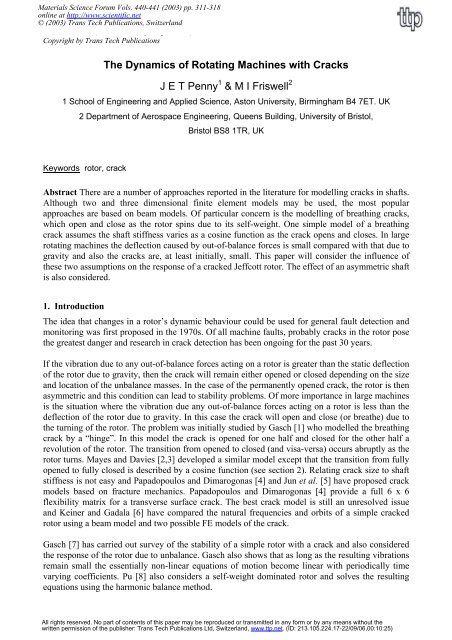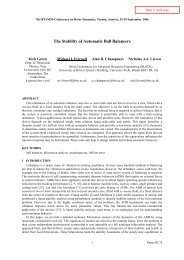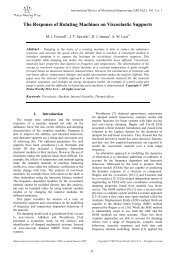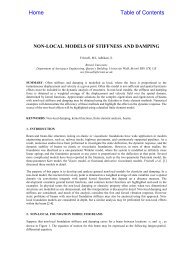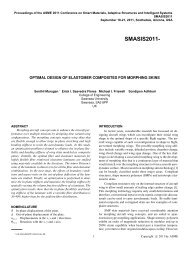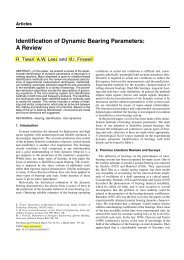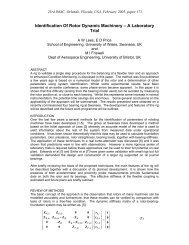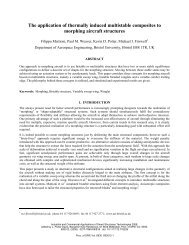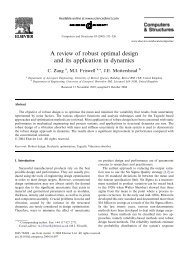The Dynamics of Rotating Machines with Cracks ... - Michael I Friswell
The Dynamics of Rotating Machines with Cracks ... - Michael I Friswell
The Dynamics of Rotating Machines with Cracks ... - Michael I Friswell
You also want an ePaper? Increase the reach of your titles
YUMPU automatically turns print PDFs into web optimized ePapers that Google loves.
Materials Science Forum Vols. 440-441 (2003) pp. 311-318<br />
online at http://www.scientific.net<br />
© (2003) Trans Tech Publications, Switzerland<br />
Journal Citation (to be inserted by the publisher)<br />
Copyright by Trans Tech Publications<br />
<strong>The</strong> <strong>Dynamics</strong> <strong>of</strong> <strong>Rotating</strong> <strong>Machines</strong> <strong>with</strong> <strong>Cracks</strong><br />
J E T Penny 1 & M I <strong>Friswell</strong> 2<br />
1 School <strong>of</strong> Engineering and Applied Science, Aston University, Birmingham B4 7ET. UK<br />
2 Department <strong>of</strong> Aerospace Engineering, Queens Building, University <strong>of</strong> Bristol,<br />
Bristol BS8 1TR, UK<br />
Keywords rotor, crack<br />
Abstract <strong>The</strong>re are a number <strong>of</strong> approaches reported in the literature for modelling cracks in shafts.<br />
Although two and three dimensional finite element models may be used, the most popular<br />
approaches are based on beam models. Of particular concern is the modelling <strong>of</strong> breathing cracks,<br />
which open and close as the rotor spins due to its self-weight. One simple model <strong>of</strong> a breathing<br />
crack assumes the shaft stiffness varies as a cosine function as the crack opens and closes. In large<br />
rotating machines the deflection caused by out-<strong>of</strong>-balance forces is small compared <strong>with</strong> that due to<br />
gravity and also the cracks are, at least initially, small. This paper will consider the influence <strong>of</strong><br />
these two assumptions on the response <strong>of</strong> a cracked Jeffcott rotor. <strong>The</strong> effect <strong>of</strong> an asymmetric shaft<br />
is also considered.<br />
1. Introduction<br />
<strong>The</strong> idea that changes in a rotor’s dynamic behaviour could be used for general fault detection and<br />
monitoring was first proposed in the 1970s. Of all machine faults, probably cracks in the rotor pose<br />
the greatest danger and research in crack detection has been ongoing for the past 30 years.<br />
If the vibration due to any out-<strong>of</strong>-balance forces acting on a rotor is greater than the static deflection<br />
<strong>of</strong> the rotor due to gravity, then the crack will remain either opened or closed depending on the size<br />
and location <strong>of</strong> the unbalance masses. In the case <strong>of</strong> the permanently opened crack, the rotor is then<br />
asymmetric and this condition can lead to stability problems. Of more importance in large machines<br />
is the situation where the vibration due any out-<strong>of</strong>-balance forces acting on a rotor is less than the<br />
deflection <strong>of</strong> the rotor due to gravity. In this case the crack will open and close (or breathe) due to<br />
the turning <strong>of</strong> the rotor. <strong>The</strong> problem was initially studied by Gasch [1] who modelled the breathing<br />
crack by a “hinge”. In this model the crack is opened for one half and closed for the other half a<br />
revolution <strong>of</strong> the rotor. <strong>The</strong> transition from opened to closed (and visa-versa) occurs abruptly as the<br />
rotor turns. Mayes and Davies [2,3] developed a similar model except that the transition from fully<br />
opened to fully closed is described by a cosine function (see section 2). Relating crack size to shaft<br />
stiffness is not easy and Papadopoulos and Dimarogonas [4] and Jun et al. [5] have proposed crack<br />
models based on fracture mechanics. Papadopoulos and Dimarogonas [4] provide a full 6 x 6<br />
flexibility matrix for a transverse surface crack. <strong>The</strong> best crack model is still an unresolved issue<br />
and Keiner and Gadala [6] have compared the natural frequencies and orbits <strong>of</strong> a simple cracked<br />
rotor using a beam model and two possible FE models <strong>of</strong> the crack.<br />
Gasch [7] has carried out survey <strong>of</strong> the stability <strong>of</strong> a simple rotor <strong>with</strong> a crack and also considered<br />
the response <strong>of</strong> the rotor due to unbalance. Gasch also shows that as long as the resulting vibrations<br />
remain small the essentially non-linear equations <strong>of</strong> motion become linear <strong>with</strong> periodically time<br />
varying coefficients. Pu [8] also considers a self-weight dominated rotor and solves the resulting<br />
equations using the harmonic balance method.<br />
All rights reserved. No part <strong>of</strong> contents <strong>of</strong> this paper may be reproduced or transmitted in any form or by any means <strong>with</strong>out the<br />
written permission <strong>of</strong> the publisher: Trans Tech Publications Ltd, Switzerland, www.ttp.net. (ID: 213.105.224.17-22/09/06,00:10:25)
312<br />
Modern Practice in Stress and Vibration Analysis<br />
2 Title <strong>of</strong> Publication (to be inserted by the publisher)<br />
2 <strong>The</strong> Mayes model for an opening and closing crack<br />
This model is defined, in rotating coordinates, by<br />
and<br />
k<br />
k<br />
<br />
<br />
<br />
kM<br />
kDC1<br />
(1a)<br />
<br />
kM<br />
kDC1<br />
(1b)<br />
where k<br />
1<br />
M k0<br />
k<br />
, k<br />
1<br />
D<br />
k0<br />
k<br />
, etc., and C<br />
2<br />
2<br />
1 cos . When <br />
closed and kk k0<br />
. When cos 1<br />
k k .<br />
<br />
<br />
the crack is fully open and<br />
cos 1 the crack is<br />
k<br />
<br />
<br />
k ,<br />
<strong>The</strong> stiffnesses in fixed coordinates can be determined by transforming from rotating coordinates so<br />
that<br />
T<br />
K F T K RT<br />
(2)<br />
<br />
where<br />
C1<br />
S1<br />
<br />
T . (3)<br />
<br />
S1<br />
C1<br />
<br />
<br />
In (3), S1 sin<br />
. Carrying out the matrix multiplications <strong>of</strong> (2) and expanding the trigonometric<br />
expressions in multiple angles gives<br />
1<br />
K<br />
<br />
1<br />
k<br />
k S<br />
k<br />
k S<br />
<br />
F 12 2 M M<br />
2 4 D<br />
D<br />
1 S3<br />
or<br />
K 1<br />
k k S S S <br />
<br />
<br />
1<br />
F <br />
12 4 2 <br />
2 1 3<br />
(4)<br />
where S <br />
and<br />
3 sin 3 , etc. Similarly<br />
1 1<br />
1<br />
F D D D D 3<br />
D D D D<br />
<br />
K k 11 0 k k k k C<br />
2 2 2 k k C<br />
4<br />
1 k k C3<br />
(5)<br />
1 1<br />
1<br />
F D D D D 3<br />
D D D D<br />
<br />
K k 22 0 k k k k C<br />
2 2 2 k k C<br />
4<br />
1 k k C3<br />
. (6)<br />
Now, if t , where is the rotor angular velocity, then in fixed coordinates the Mayes model<br />
generates a constant term plus 1X, 2X and 3X rotor angular velocity components in the diagonal<br />
stiffness terms and 1X, 2X and 3X rotor angular velocity components in the <strong>of</strong>f-diagonal stiffness<br />
terms.<br />
3. Approximating the Equations <strong>of</strong> motion<br />
<strong>The</strong> analysis may be performed in fixed or rotating coordinates. If the bearings and foundations are<br />
axi-symmetric then the stator dynamic stiffness will appear constant in the rotating frame, and there<br />
is some benefit in analysing the machine in rotating coordinates. Typically foundations will be
Materials Science Forum Vols. 440-441 313<br />
stiffer vertically than horizontally, and in this case the advantage in using rotating coordinates is<br />
significantly reduced. Thus in this paper the machine is analysed in fixed coordinates.<br />
In fixed coordinates we have , t 0 D ,<br />
t<br />
for the undamaged beam and ,<br />
t<br />
K K K where K 0 is the diagonal stiffness matrix<br />
K is the stiffness change due to damage. is the angle<br />
D<br />
between the crack axis and the rotor response at the crack location and determines the extent to<br />
which the crack is open. Let the deflection the system be q q st qu<br />
where q st is the static<br />
deflection and q u is the deflection due to whirl. Thus, q q u and q<br />
q u , and the equations <strong>of</strong><br />
motion in fixed coordinates is<br />
t <br />
Mq D G q K K q q Q W<br />
(7)<br />
u u 0 D , st u u<br />
Q u and W are the out <strong>of</strong> balance forces and gravitational force respectively. Damping and<br />
where<br />
gyroscopic effects have been included as a symmetric positive semi-definite matrix D and a skewsymmetric<br />
matrix G, although they have little direct bearing on the analysis. If there is axisymmetric<br />
damping in the rotor then there will also be a skew-symmetric contribution to the<br />
undamaged stiffness matrix, K 0 . We refer to (7) as the “full equations”.<br />
<strong>The</strong>re are two approximations that are commonly used in the analysis <strong>of</strong> cracked rotors, namely<br />
weight dominance and neglecting the parametric excitation terms. <strong>The</strong>se will be dealt <strong>with</strong> in turn.<br />
Weight dominance. One common assumption is that the static deflection is much greater that the<br />
response due to the unbalance or rotating asymmetry, that is qst qu<br />
. For example, for a large<br />
turbine rotor the static deflection might be <strong>of</strong> the order <strong>of</strong> 1 mm whereas at running speed the<br />
amplitude <strong>of</strong> vibration is typically 50 m. Even at a critical speed the allowable level <strong>of</strong> vibration<br />
will only be 250 m. In this situation that the crack opening and closing is dependent only on the<br />
static deflection and thus that t<br />
0 , where is the rotor speed and 0 is the initial angle.<br />
K ,<br />
t K t is a period function <strong>of</strong> time and the full non-linear equation (7)<br />
Thus is this case <br />
D<br />
D<br />
becomes a linear parametrically excited equation. We refer to this as the “weight dominance<br />
assumption”.<br />
Neglecting the parametric excitation terms. Generally cracks are small, and so not only does<br />
q q K K<br />
K , t q is second order and may<br />
st<br />
, also . This means that the term <br />
u<br />
0 D <br />
be ignored. Since, from the static solution, Kq 0 st <br />
t<br />
u u 0 u u D ,<br />
st<br />
D<br />
W, equation (7) becomes,<br />
Mq D G q K q Q K q , (8)<br />
which is a forced linear system, if weight dominance is also assumed. In this case we refer to (8) as<br />
“weight dominance ignoring parametric excitation”. If weight dominance is not assumed, then the<br />
K ,<br />
t , depends on the response in a non-linear way.<br />
crack is opening and closing, and hence <br />
D<br />
For a stability analysis the parametric terms are very important and must be included [7], although<br />
for a parametrically excited system the stability is not affected by the steady state solution, which<br />
therefore does not have to be calculated.<br />
u
314<br />
Modern Practice in Stress and Vibration Analysis<br />
4 Title <strong>of</strong> Publication (to be inserted by the publisher)<br />
4. A Jeffcott rotor example<br />
A Jeffcott rotor modelled using two degrees <strong>of</strong> freedom will be used to demonstrate the effect <strong>of</strong> the<br />
different assumptions in the equations <strong>of</strong> motion <strong>of</strong> the cracked rotor. <strong>The</strong> rotor is 700 mm long,<br />
<strong>with</strong> a diameter <strong>of</strong> 15 mm, and has a 1 kg disc at the centre. <strong>The</strong> crack is assumed to be located<br />
close to the disc and only responses that are symmetrical about the shaft centre are considered. <strong>The</strong><br />
natural frequency <strong>of</strong> the rotor is approximately 42 Hz the damping ratio is taken as 1%. Gyroscopic<br />
effects are neglected. An unbalance force arising from a 10 g mass at 100 mm radius is used to<br />
excite the rotor, and at t = 0 the crack is closed and the unbalance force is in the x direction.<br />
To consider the effect <strong>of</strong> weight dominance consider a crack <strong>of</strong> 40% <strong>of</strong> the diameter, modelled<br />
using the Mayes approach <strong>with</strong> stiffness reduction for the fully open crack <strong>of</strong> 9% and 4% in<br />
directions perpendicular and tangential to the crack front. <strong>The</strong>se reductions in direct stiffness due to<br />
the open crack are taken directly from the results <strong>of</strong> the model <strong>of</strong> Jun et al. [5]. A rotor speed <strong>of</strong><br />
1240 rev/min is simulated, which is just below half <strong>of</strong> the machine’s natural frequency. <strong>The</strong> static<br />
deflection <strong>of</strong> the undamaged rotor is 0.14 mm. <strong>The</strong> time simulations are run until the transient<br />
motion becomes negligible and the steady state solution remains. Figure 1 compares the orbit <strong>of</strong> the<br />
full solution <strong>of</strong> the equations <strong>of</strong> motion (solid) and the weight dominated solution (dotted) when<br />
there is no unbalance force. Clearly the assumption <strong>of</strong> weight dominance is a good one. When the<br />
4<br />
unbalance increases to 10 kg m the assumption <strong>of</strong> weight dominance is not so good, and there is<br />
clearly some difference in the phase when the crack opens and closes (Figure 2). By the time the<br />
3<br />
unbalance has increase to 10 kg m there is a qualitative difference in the weight dominated<br />
solution, which still shows a significant 2X response, and the full solution which shows<br />
4<br />
predominantly a 1X response (Figure 3). Note that <strong>with</strong> unbalance <strong>of</strong> 10 kg m the vertical<br />
displacement never becomes positive, that is the response from the unbalance is always a smaller<br />
3<br />
magnitude than the static deflection due to gravity. This is not so for an unbalance <strong>of</strong> 10 kg m.<br />
0.0<br />
0.0<br />
-0.1<br />
-0.1<br />
-0.2<br />
-0.2<br />
-0.3<br />
-0.1 0 0.1<br />
Figure 1. Comparison <strong>of</strong> the rotor orbit <strong>with</strong><br />
no unbalance. Full equations (solid), weight<br />
dominance assumption (dotted). All<br />
dimensions in mm.<br />
-0.3<br />
-0.1 0 0.1<br />
Figure 2. Comparison <strong>of</strong> the rotor orbit <strong>with</strong><br />
4<br />
an unbalance <strong>of</strong> 10 kg m. Full equations<br />
(solid), weight dominance assumption<br />
(dotted). All dimensions in mm.
Materials Science Forum Vols. 440-441 315<br />
0.5<br />
0.0<br />
0<br />
-0.1<br />
-0.5<br />
-0.2<br />
-1<br />
-1 -0.5 0 0.5<br />
Figure 3. Comparison <strong>of</strong> the rotor orbit <strong>with</strong><br />
3<br />
an unbalance <strong>of</strong> 10 kg m. Full equations<br />
(solid), weight dominance assumption<br />
(dotted). All dimensions in mm.<br />
-0.3<br />
-0.1 0 0.1<br />
Figure 4. Comparison <strong>of</strong> the rotor orbit <strong>with</strong><br />
no unbalance for a large crack. Full equations<br />
(solid), weight dominance ignoring<br />
parametric excitation (dotted). All dimensions<br />
in mm.<br />
Figure 4 compares the response <strong>of</strong> the full equations <strong>with</strong> those where the parametric excitation has<br />
been ignored. Clearly there is a large difference, although it could be argued that a crack <strong>of</strong> 40% <strong>of</strong><br />
the diameter <strong>of</strong> the shaft is every large. Figure 5 compares the responses when the crack is much<br />
smaller, simulated making the stiffness reduction one tenth <strong>of</strong> that due to a 40% crack. Clearly the<br />
response are now very close.<br />
5. An Asymmetric Shaft<br />
Consider a rotor <strong>with</strong> asymmetric stiffness properties k H and k L in the orthogonal directions ()<br />
and assume that a crack develops <strong>with</strong> a crack face at an angle to the direction . For simplicity a<br />
rotor <strong>with</strong> a circular section is assumed. Let the rotor stiffnesses in the () rotating coordinates be<br />
k H and k L . In the () rotating coordinates the stiffness matrix becomes<br />
<br />
<br />
2 2<br />
kHC kLS kH kL<br />
S C <br />
<br />
K R <br />
<br />
(9)<br />
<br />
2 2<br />
kH kLSC kHS kLC<br />
<br />
Consider for simplicity the Mayes crack model. <strong>The</strong>n the stiffnesses in the () directions when<br />
the crack is open are<br />
<br />
k<br />
k<br />
t 0 <br />
K Rc <br />
<br />
(10)<br />
<br />
0 kk<br />
t <br />
where k (for example) is the reduction in stiffness due to the open crack in the direction. In<br />
this case we have<br />
2 2<br />
<br />
2 2<br />
k k S C k S k C k t<br />
kHC kLS k t kH kL<br />
S C <br />
K Rc <br />
<br />
(11)<br />
<br />
H L H L
316<br />
Modern Practice in Stress and Vibration Analysis<br />
6 Title <strong>of</strong> Publication (to be inserted by the publisher)<br />
Let<br />
2 2<br />
0 H L <br />
k k C k S ,<br />
2 2<br />
0 H L <br />
k k S k C<br />
and <br />
k k k S C .<br />
0 H L <br />
Assume a Mayes model, and let<br />
<br />
0 2 , kD k k<br />
k k k<br />
M <br />
0 2<br />
<br />
0 2 , kD k <br />
k<br />
k k k<br />
M <br />
0 2<br />
Thus equation (11) becomes<br />
kM kDC1 k0<br />
<br />
K Rc <br />
<br />
(12)<br />
<br />
k0 kM kDC1<br />
<br />
Now in fixed coordinates the stiffness matrix is given by<br />
Fc<br />
T<br />
K T K T (13)<br />
Rc<br />
This leads to the following expressions<br />
1 1<br />
F D D M M <br />
k k k S S k k S k C<br />
12<br />
4 1 3 2 2 0<br />
2<br />
and<br />
1 1 1 1<br />
F M M 3<br />
D D M M D D <br />
k k k k k C k k C k k C k S<br />
11<br />
2 4 1 2 2 4 3 0<br />
2<br />
1 1 1 1<br />
F M M D 3 D M M D D <br />
k k k k k C k k C k k C k S<br />
22<br />
2 4 1 2 2 4 3 0<br />
2<br />
Note that this isn’t quite as simple as the symmetric rotor because <strong>of</strong> the additional k 0<br />
term and<br />
also because k0<br />
k0. In the symmetric rotor k0 0 and k0<br />
k0<br />
k0.<br />
Figure 6 shows the response <strong>of</strong> the Jeffcott rotor described in the previous section for an unbalance<br />
4<br />
<strong>of</strong> 10 kg m, as the solid line. This is the same response as given in Fig. 2. Also shown (dashed) is<br />
the response <strong>of</strong> the uncracked shaft, but <strong>with</strong> a 3% stiffness asymmetry in the shaft and =0.<br />
Although the responses are quantitatively different, both have a significant 2X component, as<br />
expected, and they have similar magnitudes. However when the response <strong>of</strong> the cracked asymmetric<br />
shaft is computed (dotted) the response magnitude is smaller, and the 2X component <strong>of</strong> the<br />
response is significantly reduced. If the cracked shaft were monitored, then as the crack propagated<br />
there would be a reduction in the 2X response, before the crack grew sufficiently to dominate the<br />
response.
Materials Science Forum Vols. 440-441 317<br />
0.0<br />
-0.14<br />
-0.1<br />
-0.2<br />
-0.15<br />
-5 0 5<br />
× 10 -3<br />
Figure 5. Comparison <strong>of</strong> the rotor orbit <strong>with</strong><br />
no unbalance, for a small crack. Full<br />
equations (solid), weight dominance ignoring<br />
parametric excitation (dotted). All dimensions<br />
in mm.<br />
-0.3<br />
-0.1 0 0.1<br />
Figure 6. Comparison <strong>of</strong> the rotor orbit <strong>with</strong><br />
4<br />
an unbalance <strong>of</strong> 10 kg m. Crack <strong>with</strong><br />
symmetric shaft (solid), crack <strong>with</strong><br />
asymmetric shaft (dotted), asymmetric shaft<br />
only (dashed).<br />
Conclusions<br />
In this study the steady state orbits <strong>of</strong> a cracked Jeffcott rotor at a speed just below half the rotor<br />
natural frequency are simulated and different crack model assumptions are compared. <strong>The</strong> static<br />
deflection <strong>of</strong> the rotor is 0.14 mm. With no unbalance the weight dominance assumption is<br />
satisfactory and the orbit shows predominantly a 2X response. With an unbalance <strong>of</strong> 10 kg m the<br />
2X response is less predominant and weight dominance assumption is less good, but still<br />
3<br />
acceptable. With an unbalance <strong>of</strong> 10 kg m the weight dominance assumption is no longer valid<br />
and the whirl orbit is larger than the static deflection. <strong>The</strong> orbit derived from the solution <strong>of</strong> the full<br />
equations shows predominantly a 1X response whereas the weight dominance assumption clearly<br />
contains some 2X response. Ignoring the parametric excitation terms is acceptable only if the crack<br />
is small so that the amplitude <strong>of</strong> the whirl orbit is small compared <strong>with</strong> the static deflection. If this<br />
condition is not met the parametric excitation terms cannot be ignored.<br />
With asymmetric shafts there is the possibility that the 2X response can reduce as the crack grows.<br />
This is counter-intuitive, and is critically dependent on the phase <strong>of</strong> the crack, the shaft asymmetry<br />
and the unbalance.<br />
References<br />
[1] R. Gasch, Dynamic behaviour <strong>of</strong> a simple rotor <strong>with</strong> a cross sectional crack, International<br />
Conference on Vibrations in <strong>Rotating</strong> Machinery, Paper C178/76, IMechE, (1976), pp. 123-128.<br />
[2] I.W. Mayes, W.G.R. Davies, A method <strong>of</strong> calculating the vibrational behaviour <strong>of</strong> coupled<br />
rotating shafts containing a transverse crack, International Conference on Vibrations in <strong>Rotating</strong><br />
Machinery, Paper C254/80, IMechE, (1980), pp. 17-27.<br />
[3] I.W. Mayes, W.G.R. Davies, Analysis <strong>of</strong> the response <strong>of</strong> a multi-rotor-bearing system<br />
containing a transverse crack in a rotor, Journal <strong>of</strong> Vibration, Acoustics, Stress and Reliability in<br />
Design, Vol. 106, No. 1, (1984), pp. 139-145.<br />
4
318<br />
Modern Practice in Stress and Vibration Analysis<br />
8 Title <strong>of</strong> Publication (to be inserted by the publisher)<br />
[4] C.A. Papadopoulos and A.D. Dimarogonas, Coupling <strong>of</strong> bending and torsional vibrations <strong>of</strong> a<br />
cracked Timoshenko shaft, Ingenieur Archive, Vol 57, (1987), pp495-505.<br />
[5] O.S. Jun, H.J. Eun, Y.Y. Earmme, C.-W. Lee, Modelling and vibration analysis <strong>of</strong> a simple<br />
rotor <strong>with</strong> a breathing crack, Journal <strong>of</strong> Sound and Vibration, Vol. 155, No. 2, (1992), pp. 273-290.<br />
[6] H. Keiner and M.S. Gadala, Comparison <strong>of</strong> different modelling techniques to simulate the<br />
vibrations <strong>of</strong> a cracked rotor, Journal <strong>of</strong> Sound and Vibration, Vol. 254, No. 5, (2002), pp. 1012-<br />
1024.<br />
[7] R. Gasch, A survey <strong>of</strong> the dynamic behaviour <strong>of</strong> a simple rotating shaft <strong>with</strong> a transverse crack,<br />
Journal <strong>of</strong> Sound and Vibration, Vol. 160, No. 2, (1993), pp. 313-332.<br />
[8] Y.P. Pu, J. Chen, J. Zou and P. Zhong, Quasi-periodic vibration <strong>of</strong> cracked rotor on flexible<br />
bearings, Journal <strong>of</strong> Sound and Vibration, Vol. 251, No. 5, (2002), pp. 875-890.


